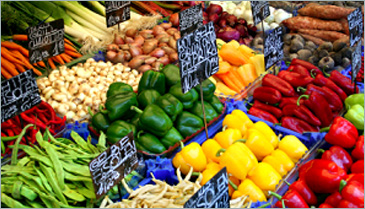 by Diana Chaplin
by Diana Chaplin
August 2, 2012
Many of us love the idea of a diverse, colorful salad because it is visually appealing. But beyond creating a vibrant plate, did you know varying your colors is good for your health?
Identifying the multitude of health benefits for each individual food can be a challenge, even for a savvy Health Coach. There’s just so many of them! But while whole foods like vegetables and fruit contain enough complex sources of nourishment to make your head spin if you tried to learn them all, they are generally categorized into a limited number of colors.
Thanks to the same phytonutrients (also known as phytochemicals) that offer plants protection from ultraviolet radiation and pests, all natural foods have a unique color, flavor, and smell. Simply looking at their color can give you great insight as to what element of health various foods are likely to support.
Most importantly, eating a wide array of colors every day is the best approach to getting all the vitamins and minerals your body needs.
Here are the most common food colors and their beneficial attributes:
White natural foods have a wide range of beneficial nutrients, such as anthoxanthins, sulfur, and quercetin. These substances boost the immune system because they are anti-viral, anti-fungal, and anti-inflammatory, which helps the body fight infections.
Examples of white foods include garlic, onions, cauliflower, and daikon radish.
Green foods get their color from chlorophyll, a natural blood purifier that supports the liver and kidneys in the elimination of toxins. Among many other nutrients, green foods also contain high amounts of Vitamin K, which is necessary for blood clotting and building strong bones.
Examples of green foods include kale, broccoli, spinach, green beans, and celery.
Yellow foods are rich in Vitamin C, which helps reduce inflammation, prevent allergies, and maintain healthy skin, due to its’ ability to combat free radicals. Yellow foods also contain citrus bioflavanoids, which strengthens the collagen in your skin, tendons, ligaments, and cartilage.
Examples of yellow foods include lemons, pineapples, yellow peppers, and grapefruit.
Orange foods are high in beta-carotene, which our bodies transform into Vitamin A and antioxidants. These nutrients aid in the prevention of cancer, heart disease, and infections by supporting an important part of the immune system: our mucous membranes. Beta-carotene also helps maintain healthy eyes and skin.
Examples of orange foods include carrots, cantaloupe, sweet potatoes, squash, and oranges.
Red foods are rich in the phytonutrients lycopene and anthocyanin, which greatly benefits the circulatory system by helping build healthy cell walls. This improves blood pressure, organ function, and circulation. Red foods also offer sun protection from harmful UV damage.
Examples of red foods include tomatoes, watermelon, beets, and red bell peppers.
Purple foods contain the most antioxidants of all the colors and therefore contribute to overall health, disease prevention, and longevity. They also raise HDL (the “good”) cholesterol, and help maintain a healthy brain.
Examples of purple/blue foods include blueberries, blackberries, eggplant, and purple cabbage.
What are your favorite colorful, healthy recipes?




